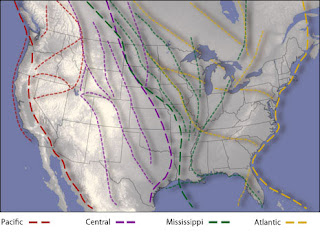 |
| Painted Bunting |
In addition to the time of year, birders must also be mindful of the four main migration flyways birds use as they pass into or through the United States: Pacific, Central, Mississippi, and Atlantic. Given our location in Texas, keeping to the Central and Mississippi flyways would provide us with our best shot at catching many of the migrants as they - and we - headed toward Wisconsin.
 |
| four major migratory flywways |
 |
| site 149 at Goose Island State Park |
Aside from narrow roads, tight sites and the muggies, the next impossible to overlook problem was a multitude of voracious mosquitoes. Hordes of them. During our week's stay we were never able to spend any time outside without mosquito repellent. Strong mosquito repellent. If there had been as many birds as there were mosquitoes we would have been in birding nirvana.
 |
| one of the Geiger's water drips (note small depression to collect water) |
 |
| Larry and Judy Geiger |
 |
| hanging out at the Geiger's |
 |
| Black Skimmer |
One could not visit Rockport without learning about Connie Hagar, a backyard birder who's early observations of bird migrations set the widely held migration theories of professional ornithologists on their heads. As a result of her work many long held bird migrations theories would be overturned and rewritten.
 |
| Orchard Oriole (male) seen from tower at Aransas |
 |
| Inca Dove on nest |
 |
| view from Charlotte Plummer's |
In the afternoon we stopped at Mustang Island State Park before catching the free ferry back toward Rockport and a stop at McDonald's free wi-fi. Foregoing McDonald's menu we opted for drinks and dinner at Charlotte Plummer's Seafare Restaurant overlooking the Rockport harbor.
 |
| breakwater jetty at Mustang Island State Park |
 |
| unusual in east TX but record early as well MacGillivary's Warbler |
 |
| Worm-eating Warbler |
 |
| White-eyed Vireo taking a mister bath |
 |
| site at Brazos Bend |
We had heard many good things about Brazos Bend State Park located further up the Texas coast just south of Houston. With a nice southerly tailwind to push us north (the same southerly winds that no doubt kept pushing migrants further north and out of our sight) we arrived at Brazos Bend State Park (BBSP). Where narrow roads and tight sites were the norm at GISP, it was quite the opposite at BBSP. Huge sites separated by lots of space. A power outage during the early hours following our first night at first seemed like a major inconvenience - we might have to move to another section. The ranger offered everyone in our section the offer to move but also seemed convinced the problem would be fixed late in the day. The two other sites that were occupied elected to move but we stayed and in the end, wound up having no neighbors during the rest of our stay...unless one counted numerous Barred Owls and a new life yard bird: Acadian Flycather.
 |
| signs were everywhere |
 |
| as were alligators |
The big draw to the park for many folks isn't birds but American Alligators. So numerous are the gators that signs are posted everywhere to beware and to stay a minimum of 30 feet away. Apparently the gators failed to get the memo or if they did to ignore the distance rule. Quite often we would come across a gator sprawled on one of the trails. You have to realize that most of the trails are hardly 12 feet wide. We had to keep reminding ourselves that the gators were more afraid of us than we were of them as we gingerly skirted any we encountered. A little disconcerting at this time of year as bull gators were heard and seen roaring in the surrounding bayous and lakes.
 |
| view from Elm Lake overlook |
 |
| one of many oxbows |
 | ||
| Purple Gallinule |
 |
| Black-bellied Whistling Duck |
 |
| Black-crowned Night-Heron |
 |
| White Ibis |
 |
| always had to be on guard |




Very informative. Hopefully we will get to Brazos Bend soon. Have not missed the mosquitoes since we left the south.
ReplyDeleteYes, we ran out of mosquitoes in southern Illinois...and now finding cooler temps, too!
ReplyDelete